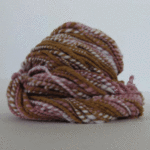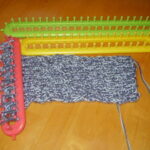Years ago, I dated a body builder. Since I was an avid knitter, I decided I wanted to make him a custom sweater. Armed with a tape measure, my pattern and my gauge, I started to record his measurements. I found out rather quickly that I faced special challenges.
After several pattern changes and test pieces, I figured it out. Since then, I have made custom sweaters for more than a few athletes. I’d like to share what I’ve learned. I have been not been able to find any books on the market that explain how to design knitting patterns for athletes.
Basic Pattern:
Begin with a basic sweater pattern without a fancy or involved neckline. Once you have some experience with the special designs required, you can incorporate any neckline you choose.
Draw out basic pattern shapes for sleeves, front and back for your sweater. Leave off any cuffs, neckband or waistband at this time.
Body Styles:
There are two types of body style for athletes. Swimmers, runners and such are slender. They have no large muscles that require special planning. You may have to take in your pattern, lengthen arms or torso. That’s about it.
The second type is the “muscle” build. Body builders, boxers, extreme fighters, wrestlers and so on are in this category. Check your patterns measurements. You’ll see examples such as:
1. Measurements for arms- 21″-24″ long and 12″-14″ around upper arms. Okay. This sleeve will not fit around arms that measure 20″ or more around the upper arm. You’ll need to increase the number of stitches dramatically for fit. Add more stitches for movement and ease. If the person is going to flex the upper arm while wearing the sweater, measure the arm flexed and plan for this measurement.
2. The neck area will be different for bodybuilders than it will for most people. The neck and shoulders in most people are relatively flat; the body builder’s shoulders and neck will angle upward. You will need to work out extra stitches and a new neck and shoulder line for the sweater to look natural.
Try not to make the neckline too tube like or it will exaggerate the height of the neck muscles and look unnatural. Using a boat neck will have the same effect. Trial and error will produce a neckline you and the person can be comfortable with.
3. The chest is obviously larger than most people’s chest measurements; the waist decidedly smaller. You do not want to make a waist so small that the sweater cannot be pulled over the head.
This may appear to present a terrific problem; if the sweater will fit over the shoulders and chest it may appear to loom around the waist. Choose a sweater pattern such as a wrap, fisherman or other type that flatters the wearer.
4. The sleeves should come to the end of the arms, depending on the style. Cuffs can be added to this length or the sweater can end above the wrist and the cuff added to the length.
5. A springy waistband should be added instead of a stiff one. This allows the sweater to flow and hide the waist instead of accent it.
A tunic sweater should end just above the wearer’s hipbone. Depending on the style, it can be shorter or longer if desired.
Once you have obtained your gauge by knitting a sample piece and measuring how many stitches you have per inch horizontally and rows vertically, you can figure out how many stitches you need to make your sweater.
Notes:
- · This is a project best left to an experienced knitter. Beginners should practice shaping by decreasing on one side or another of a piece of work. By noticing how the project “leans,” you can shape anything from either or both sides. This is how necklines, shoulder lines and other pieces are shaped.
- · Once you have successfully knitted a fitting sweater in basic garter or stockinette stitch, you can incorporate stitch patterns into the pieces.
- · Do not get discouraged- this is not as easy as it sounds. Athletes have special fitting needs, just like people with conditions such as osteoporosis, obesity and other body shapes.
- · If you knit for several athletes, keep in mind that you will need to adjust the pattern for each person.
The results can be spectacular. Athletes appreciate clothing that fits; having it made by someone they care about is even better. I have found that raglan sleeves used with different sweaters such as pullovers and cardigans do not draw excessive attention to the athlete’s neck or large shoulders. They allow the sweater to flow. With cardigans, designing a collar that measures halfway between the neck and shoulder point at its widest and tapers down will look appropriate for the athlete’s neck, shoulders and chest.
Source: The author of this article has over 40 years of experience in diverse forms of DIY, home improvement and repair, crafting, designing, and building furniture, outdoor projects, RV’ing and more.







